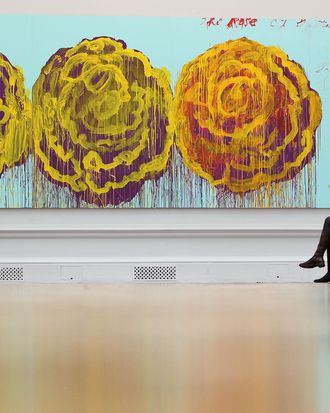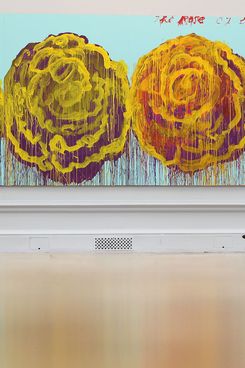

Cy Twombly, a giant of post-war American Art, died today at 83. Along with Jasper Johns and Robert Rauschenberg, he moved painting beyond the heroic domains of Abstract Expressionism. Where his predecessors worked in brawny swaths of paint, Twombly focused on the delicate, scratching and scribbling, fusing looping calligraphic line, odd marks, raw smudges, blackboard-like scrawls, and gorgeous visceral color with intimations of myth, narrative, and a Whitman-esque feel for effusion and the erotic. (Roland Barthes once wrote that TwomblyÔÇÖs marks conjure ÔÇ£English colleges, Latin verses, desks, notations in finely written pencil.ÔÇØ)
Unlike so many of his contemporaries, he wasnÔÇÖt a New York creation. In the fifties, the young Twombly traveled with Rauschenberg to Italy and North Africa, and ÔÇö whether through the travel or the close contact with the titanic talent of Rauschenberg, who had a way of imbuing those around him with genius ÔÇö Twombly soon erupted with a series of tantalizing, orgiastic scenes of scrotal shapes, flying vaginas, floating pudenda, abstract anuses, and a liquidity that art critic David Sylvester once compared to stains left on bed sheets after lovemaking. These paintings are aphrodisiacal abstract seas wafting with ironic distance. You immediately know that they arenÔÇÖt just action paintings or accidental splatters but are born of mind as much as body, and they put Twombly on the art-historical map.
Almost perversely, as soon as the American art world exploded in the sixties, with Twombly positioned near the center of it all, he left America for good. Moving to Italy made him less a contemporary artist and more of a living legend ÔÇö a sort of American Balthus, almost never heard from. By the turn of the millennium, he hadnÔÇÖt had a New York gallery show in almost 30 years. His work grew to seem exotic and once-removed.
Then he exploded again. Over the final decade of his life Twombly equaled his original work and surpassed it, making tremendous late abstract works that tell vast tales of ancient armies, otherworldly invasions of burning suns and radiating chrysanthemums. Works from this period invoke twelfth-dynasty Egyptian pharaohs; armadas of barges at sea; chariots of color; exoduses, love, loss, and longing. Convulsive brushstrokes, surging bursts of light, handwritten scribbles, epic format, and luxuriant saturated color, combine to create something majestic, almost like fresco painting. Twombly not only didnÔÇÖt go gentle into any good night ÔÇö heÔÇÖd embarked on a voyage to some painterly place where uncontrollable feelings, experience, expectation, dreams, and love become one.
He gave me a part of my artistic life, too. TwomblyÔÇÖs fusing of thought, mark-making, narrative, history, myth, and formalism made me see that there is no such thing as purely abstract or representational art. HeÔÇÖs the artist who made me see that all art is equally abstract and that something as simple as handwriting and scribbling, unleashed, can be art. TwomblyÔÇÖs paintings allow one to rise to the heights of Abstract Expressionism without the air being so thin. His art gave me my first true abstract representation of sex, allowing me, as Patti Smith said of the Rolling Stones, to begin ÔÇ£thinking between my legs.ÔÇØ

